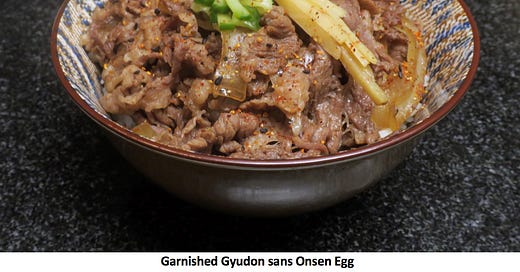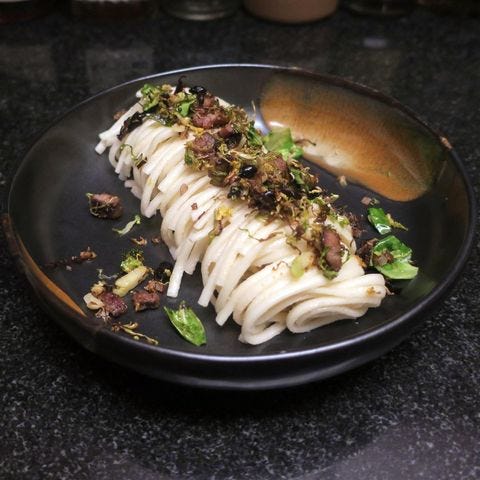How to Make a Perfect Japanese Rice Bowl, with Tom Kretchmar
Plus: Why Gail Arnold says you should put chocolate and Trader Joe's taco mix in your stew
For today’s ~special weekend edition~ of the newsletter, I’m interviewing two guests who are experts in home cooking: Gail Arnold, a legendary chef known for cooking in Steven Spielberg’s home; and Tom Kretchmar, known for having the most delicious looking Japanese food in my Instagram feed. Unlike most of the guests on Cooking in Quarantine, there’s a high likelihood you don’t know their names, but if you want to make a good meal this weekend, you’d be a fool not to give their recipes a shot.

Editor’s Note: Rocky III is the best Rocky, and it’s not even close. Sam Koppelman is not accepting rebuttals at this time.

This newsletter, which is ostensibly about chefs, has already featured Beto O’Rourke, Caroline Calloway, and Seth Godin. And yet, Tom Kretchmar might be the most surprising guest yet—because, by day, he works as a divorce lawyer. But by night, Tom is one of the foremost experts on Japanese cooking (at least for a white dude) and a card-carrying member of the foodminati.
Over the course of quarantine, he’s been posting dishes he says exemplify the idea of “austerity with flair,” filleting smoked eel in one Instagram and then eating its bones a few posts later. In today’s newsletter, he dives into his approach to cooking during this time; and shares a simple recipe for one of his favorite dishes: Gyudon.
If you like Japanese food, you’re going to want to read this interview. And if you don’t, well, and I mean this politely, what the fuck is wrong with you?
On the Origins of “Austerity With Flair”
Tom: I’m very committed to this idea that right now, we’ve got to respect the circumstances we’re in. I think we need to make really mindful choices about what we’re eating and how we’re eating it—to be cognizant that there are real consequences of every food-related act of ours right now, in terms of our own health, the health of everyone who’s participating in the food-supply chain, and whether we’re being responsible or reckless in terms of burdening the infrastructure around us.
That’s how I came up with the idea of “austerity with flair.”
In ordinary times, privileged people in the United States don’t think about this stuff, but over the course of human history, times of austerity have always been oriented around eating food that’s built upon a foundation of starches and whatever trace amounts of protein—or, if you’re lucky, not-so-trace—that you’re able to build on top of that. That’s not Japanese, that’s not American; that’s global.
Just to be healthy and have food on the table is, right now, a blessing enough. The dining should be rewarding even if it’s nothing more than, like, a bare bowl of beans and rice.
Editor’s Note: Check out this dish to see the full extent of Tom’s austere side.
Having said that, it’s also still totally fine and important for cooking to be fun—and, to the maximal extent, rewarding. And I do think there are many ways we can elevate food in a mindful and fun way. That’s where you find the “flair.”
The two most interesting things I’ve cooked so far, in addition to the gyudon, which I’ll get to shortly, are Spam Musubi and the Udon dish I did with brussels sprouts.

Editor’s Note: If you want to learn more about how to make the Spam Musubi, Tom posted detailed directions on his Instagram.
EVERYTHING YOU NEED TO KNOW TO MAKE A PERFECT GYUDON
Tom: The question I’ve been asking myself is: how do I make a very special meal where ultimately I’m using some fundamentally basic ingredients and trying to stretch them? That dish, for me, is Gyudon.
With Gyudon, you can certainly tack on piles and piles of meat and kind of turn it into an indulgence that way. But at the end of the day, it’s just another iteration of: get most of your calories out of an easily-sourceable, low-cost starch, and have your more fanciful protein on top, to an appropriately measured extent. And I really am trying to think that way about all aspects of dining right now.

The three basic things that are going into Gyudon, outside the sauce, are onion, beef, and rice.
THE BEEF:
Tom: If you can’t find the right kind of sliced beef, just buy the stuff in the freezer case that’s meant for making cheesesteaks at home. It doesn’t have to be high-level. Just get sliced, shaved beef, follow the recipe and you’ll have a good result.
The storefront outside of Bohemian, the secret restaurant, for years was a Japanese butcher shop: Japan Premium Beef, which trades in eye-wateringly expensive, genuine, real-deal Kobe, Wagyu, $130/lb craziness. But that store also produces a lot of trimmings of these steaks. You’ll see a bunch of these hundred-plus-dollar steaks, but you’ll also see these one-pound packages the trimmings, called kiriotoshi, that are $13/lb, that are the highest-grade beef.
One of the last things I did before quarantining is I went down to Japan Premium Beef, and I bought four pounds of their Kiriotoshi, knowing that could be eight to sixteen meals. Not only is it delicious, but it’s kind of fun knowing I’m not just sitting down for a bowl of rice and beef—I’m sitting down for a bowl of rice with the fanciest beef on the earth.
THE RICE:
Tom: I always have a ton of rice around, because my cooking is very Japanese-oriented and influenced. For this dish, just use sushi rice but don’t season it. Any short-grain Japanese rice should do, though my go-to is Tamaki Gold. Another quality brand for home use is Kagayaki.
Japanese rice, at least in NYC, can be ordered via delivery through Mercato, whether from Katagiri or Sunrise Mart. Japanese grocery stores in New York are delivering right now.
THE ONIONS:
Tom: You start by putting some dashi in a pot. You can also make your dashi—it’s analogous to making your chicken stock—if you have kombu and bonito flakes. If people don’t have dashi on hand, instant dashi is available online.
Once you’ve got your dashi going, you’re adding in sake, mirin, sugar, and soy sauce, and getting that going to a mild simmer.
Then you’re getting your onions in there. Some recipes tell you to use half, some will use a whole; it’s to taste. But the onion is important for adding a certain sweetness. It’s taking from and adding flavors to what’s essentially the broth. Once your onions have gotten translucent and have cooked down, in goes your shaved beef—you’re using a half pound, or some recipes call for more. And then it’s kind of a simmer to taste. It’s going to get cooked through very quickly. Once it looks right—if you’ve tasted Gyudon before, take a taste—but we’re talking two to three minutes. It’s done very quickly.

Tom: Stick your rice in a bowl. Put your beef on top, to whatever extent feels appropriate in terms of preserving some for the future. Throw your garnish on top.
TOGARASHI
One of the classic ways you can plate the dish is to shower it with Shichimi Togarashi, which is that Japanese seven-spice blend that you’ve seen on the counter at any Ramen shop or any Izakaya, and is readily available.
The shop in Tokyo where I bought my custom blend of shichimi togarashi, and where shichimi togarashi was originally invented, is called Yagenbori. Among other things, they’ll make you a custom blend, tailored to your preferences, of the seven different spices, and whatever seven different proportions you prefer. So I’ve got a ton of vacuum-sealed packets in my pantry of my custom blend of Yagenbori shichimi togarashi. It doesn't look like Yagenbori is available for purchase online right now, but there is more typical shichimi togarashi all over the internet, including at Katagiri and Sunrise Mart. People in NYC can order for delivery from both Sunrise Mart and Katagiri on Mercato.
PICKLED GINGER
One of the other garnishes for a classic bowl of Gyudon is beni shoga, which is that really pink pickled ginger. It’s the classic garnish. I don’t have any beni shoga in the house. Could I order some? Yeah. Could I have made the choice to involve the supply chain, and whatever consequences there are for people involved in delivery, to get beni shoga sent to my home? Yeah, I could’ve. But in my fridge, I have a batch of pickled ginger that’s almost become a legend among my friends, because the same batch has been pickling for, like, four years. So I used that.

MIKE ANTHONY’S PICKLES
Tom: What else can you garnish a bowl of Gyudon with? Scallions are kind of traditional, but I don’t have scallions. But before I went into quarantine, I was mindful of the fact that I was going to want vegetables, and I didn’t want to be the person who’s ordering in produce every four or five days, for the reasons we discussed. To me, what made a ton of sense was buying five or six pounds of mini cucumbers and pickling them.
The recipe I used was by one of my heroes, one of the greatest chefs and nicest people in the world: Mike Anthony at Gramercy Tavern. I sliced up, real fine, some of Mike’s pickles.
READ: Mike Anthony’s pickle recipe.
That makes it super fun, super special, in an easy way, and it also avoids burdening the supply chain by getting beni shoga delivered to me just so I have it.
A NOTE ON POACHED EGGS
Tom: Another very traditional garnish for Gyudon is a poached egg, or what in Japan you would call an onsen egg. But here’s the thing: You don’t want to gild the lily, right? I’ve only got 24 eggs. I’m really trying to be smart about what I’m doing with what I’ve got. Do I really need to use up a whole egg on top of what’s already kind of a beautiful put-together dinner? I opted not to. Other people’s mileage may vary.

Staple Items You Should Have In Your Pantry to Cook Japanese Food During Quarantine:
Tom: For just approaching Japanese food generally, obviously you need rice. There’s no reason everyone shouldn’t have a lot of rice on hand right now. As I said, Tamaki Gold is kind of a Cadillac brand, but not bank-breaking because at the end of the day, it’s rice. You need soy sauce, of course. Kikkoman or whatever brand. Rice vinegar is very important, and a brand that I look for there is Mizkan, although really any rice vinegar will do. It’s hard to leave mirin out—sweetened sake. Definitely dashi, and instant dashi is the way to go—the go-to brand is Hondashi. Sugar has a way of showing up.
How He’s Lost 15 Pounds Since Quarantine Started By Eating Carbs
Tom: I have spent many years of my life being an aggressively no-carb or low-carb person. Right now, I don’t have any interest in that. I don’t think that’s necessarily a responsible way to be dining. And also, what’s kind of funny is—and my friends jokingly hate me for this—since we started quarantining, I’m down around fifteen pounds.
That’s really very much a function, I think, of portion control. But to me it’s funny, because I’m eating way more rice and grains now than in an ordinary course, but doing it in a different way. It’s down fifteen pounds in a healthy way. And it really boils down to portion control, because I’m being very mindful, way more than in the ordinary course. I’m thinking, I shouldn’t really be putting more than a half a cup of rice into a meal, I shouldn’t be putting more than three ounces of an animal protein into a meal, or whatever the measurements are—when it adds up, suddenly maybe you have cut your daily caloric intake, in a healthy way.

I first heard Gail Arnold’s name a few years ago—after a couple of my friends, Ben and Sam, had one of the best meals of their lives at Bobby Flay’s restaurant Gato. When they sat down, Ben and Sam thought it would be an ordinary evening, but within minutes, Bobby was table side, helping them order and throwing in several of his favorite dishes free of charge.
When I heard this story from Sam, I asked her why they received this level of service, prompting her to respond with one word: “Gail.”
Turns out, their reservation was made by Gail Arnold, a legendary chef—who not only mentored Bobby but has spent decades personally cooking for Steven Spielberg.
Most of the chefs I’ve interviewed for this newsletter became famous cooking in restaurants. But Gail’s tips come from years spent in home kitchens, which means they’re applicable no matter who you are.
So I hope you listen to what she says. And if you’re ever making a reservation at a restaurant of Bobby Flay’s, clearly you should say that Gail sent you. Who knows? Maybe he’ll show up at your table.
ICYMI: Read Bobby Flay’s interview on Cooking in Quarantine!
Why you shouldn’t be afraid of your spices
Gail: People get so scared of spices, so they’ll make their eggs, they’ll fry their eggs, and they just never think, “Oh. Maybe I should just put a little bit of smoked paprika on there.” And that one dash of smoked paprika on top of your scrambled egg or your fried egg? It's just a total game changer. You’ve just made a different breakfast.
My husband. I love him to death, but he's like not a really creative eater; he's happy to have his eggs over hard every morning. But even for him, if I add the smoked paprika, or I'll put a little za’atar or something on top of his eggs—or even if it's in a mayonnaise, I’ll put something in there, some kind of spice—he's like, “Wow, this tastes really good today. What do you do different?” And it’s just the little dash of something that people are scared of ruining their dish. Just don't be scared.
People have these spices that they generally use for desserts around their house. And they don't think to use them for savory dishes. But I use a lot of cinnamon, I use a lot of allspice—and I’m not always using it for desserts.
If I'm making a stew, for instance, which I'm making a lot of right now, I might use allspice, a touch of cinnamon, and black pepper and some chili pepper, just to give it some mixed flavors.
I also love paprika, I just think it's a fabulous spice. I love Togarashi, the Japanese spice mix. Again, it's just something that adds pop. You know, it's really hard to get fresh mint, but a lot of Arab and Middle Eastern or Iranian cuisines use dried spearmint and that's fabulous if you want to marinate a piece of chicken or you're marinating even a pork or a fish or something.
So if you put a little bit of it on there, it just adds a certain flavor. Even if you're making a fresh salad of cucumbers, tomatoes, whatever, just put a little bit of dried mint in something.
Why you should put chocolate and taco mix in your stew
Gail: One of the ways that I make a stew is almost like a chili stew. So instead of it being ground meat, I use whatever chopped meat I can find. Somebody we know had some venison and they were going out of town, so they just gave us some venison and yesterday, I actually made a venison stew. But it could have been beef. Or I could have used pork. Or I could have used chunks of turkey if I wanted to.
It was onion, garlic, carrot, potato, chilis. If you don't have some dried chilis—like, you know, chipotles, or guajillo chilis—Trader Joe’s makes a taco seasoning mix. And so if I were going to do the cheat, I would take the taco seasoning and I would put it in that stew. It’s really good!
Sometimes I'll add more spice because I like things pretty, pretty spicy, but just to level it off, I might just take a little chunk off of a chocolate bar and throw it in there, and it smooths everything out, and I get that nice little chocolate undertone, without having to spend hours and hours making my own mole sauce.
So, you know, the easy way: taco mix and a little bit of chocolate in your regular stew. And it really will change up something most people don't think to add. When you just throw in some wine and some chicken stock, then it can be kind of boring, to be honest. But with the Mexican spice mixes, it's a game changer.
How to cook for the same people night after night
Gail: First of all, you have to know your audience. You have to know what people want. Once you know what people like, that makes it that much easier. You can have fun.
You can be in a family, and somebody is gluten free and somebody is still trying to watch their carbs or something, and another person only wants to eat meat and potatoes. So how do you navigate all of those things? What I do is think about ways that I can adapt things.
For example, I had gotten a pork shoulder a couple of days ago from the butcher. And they're big. They're like seven pounds. So I cut it in half. And then I did one Mexican-ish style, and I did one North Carolina style. But I cooked them at the same time. I prepped them at the same time. I popped them in the oven. They came out. Now I've got six meals out of that.
And then I can adapt it for each person. So if somebody wants to be careful, you can have a little side salad. And then the other person, you can add on the potato thing, or the starch thing.
The other thing is, you can do like breakfast for dinner, and it’s fine. You don't have to have the perfect meal every single solitary time
But the one thing I would say to people is that they should lead with it: “Tonight’s Cheerios for dinner. And your choices are to have it with almond milk or regular milk. You can put bananas on it, or I made a little bit of blueberry compote.” But you’ve got to be enthusiastic about what you're serving.
That, to me, is the main thing. Just be enthusiastic. “Yeah, this is a wrap for dinner. Isn’t this fantastic?” “Mom, it sucks, I hate this.” Well, great. Because that's what we're having.”
What organization you should support
Gail: No Kid Hungry.
Editor’s Note: Here a link where you can find out how to help No Kid Hungry during this crisis.
BONUS EGGPLANT RECIPE
Texted to my friend Sarah Gouda by her mother, who Sarah (correctly) dubbed “the cutest ever recipe writer.”

Sarah added: Here is my finished product. Ignore my shitty photography! It is bomb I promise.”

🍆🍆🍆🍆🍆
Until next time…





